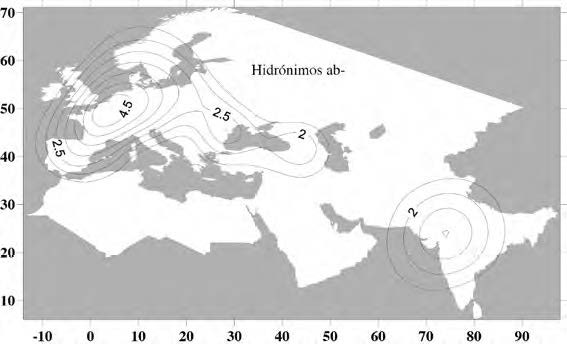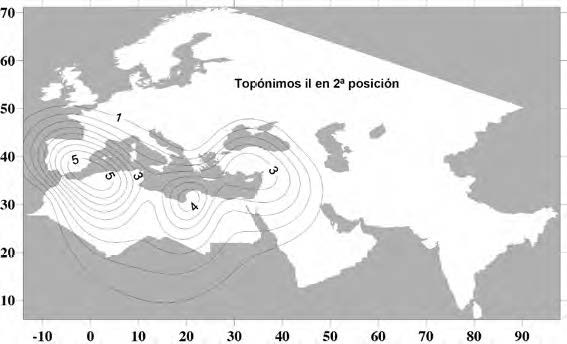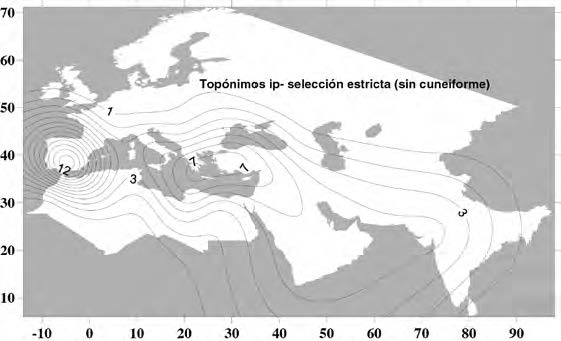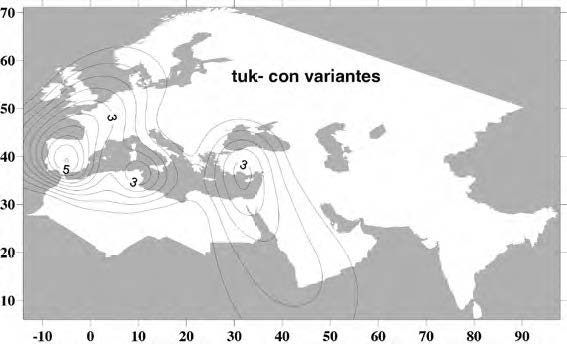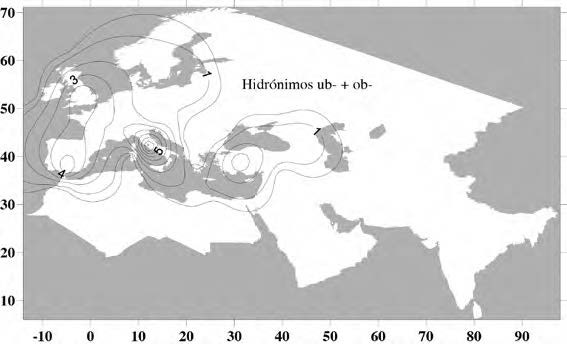These first two posts on Old European hydro-toponymy contain excerpts mainly from Indoeuropeos, iberos, vascos y sus parientes, by Francisco Villar, Universidad de Salmanca (2014), but also from materials of Lenguas, genes y culturas en la Prehistoria de Europa y Asia suroccidental, by Villar et al. Universidad de Salamanca (2007). I can’t recommend both books hardly enough for anyone interested in the history of Pre-Roman peoples in Iberia and Western Europe.
NOTE. Both books also contain detailed information on hydrotoponymy of other regions, like Northern Europe, the Aegean and the Middle East, with some information about Asia, apart from (outdated) genetic data, but their main aim is obviously the Prehistory of Iberia and neighbouring regions like France, Italy, or Northern Africa.
Series of posts on European hydrotoponymy:
- Old European substrate and its relative chronology
- Basques and Iberians after Lusitanians and “Ligurians”
- From Old European to Palaeo-Germanic and the Nordwestblock
- Tug of war between Balto-Slavic and West Uralic
- Also related: Tug of war between Balto-Slavic and West Uralic (II)
- Etruscans and Rhaetians after Italic peoples
- The British Isles and non-Indo-Europeans
- Celtic From the West or the East?
- Meshchera, a Permian wedge between Volga Finns?
- Proto-Hungarian Homeland: East and West of the Urals?
Here are only some excerpts (emphasis mine), translated from Spanish (see the original texts here), accompanied by images from both books.

Alteuropäisch and Krahe
The investigation of “Old European” or Alteuropäisch, popularized by Krahe, began precisely with the study of some toponyms and personal names spread all over Europe, previously considered “Ligurian” (by H. d’Arbois de Jubainville and C. Jullian) or “Illyrian” (by J. Pokorny), with which those linguistic groups – in turn badly known – were given an excessive extension, based only on some lexical coincidences.
This is a comment made by the author about Krahe‘s data and his opinions, frequently used against his compiled data, which I find paradoxically applicable to Villar’s data and his tentative assignment of the relative linguistic chronology to an absolute one – including the expansion of a “Mesolithic” Indo-European vs. a “Neolithic” Basque / Iberian vs. a Bronze Age Celtic – when it is now clear that the sequence of events was much later than that:
It is very widespread today a derogatory and globally disqualifying attitude to everything that sounds like Alteuropäisch and Krahe, sometimes without the necessary discrimination between different hypotheses, or even between data and hypothesis. It is not fair that the version of H. Krahe and that of W. P. Schmid be disqualified in a single simplistic judgment as if they were the same thing. But it is a major mistake to reduce the value of the hydro-toponymic data of Europe by the mere fact that Krahe attributed an implausible historical explanation to them. The data are real and still need an adequate explanation within a real historical framework, despite the unfeasibility of Krahe’s explanation.
With that we reach a point that I want to highlight. Among those who are allergic to anything that involves deviating one iota of the Indo-European paradigm as a single event, an attitude gaining momentum considers that hydro-toponymy was introduced in the different regions of Europe and Southeast Asia by the same Indo-European languages that appear historically occupying their territory. H. Krahe had argued strongly against this possibility, so now I will save myself a deeper refutation and I will limit myself to pointing out some difficulties that position is forced to face.
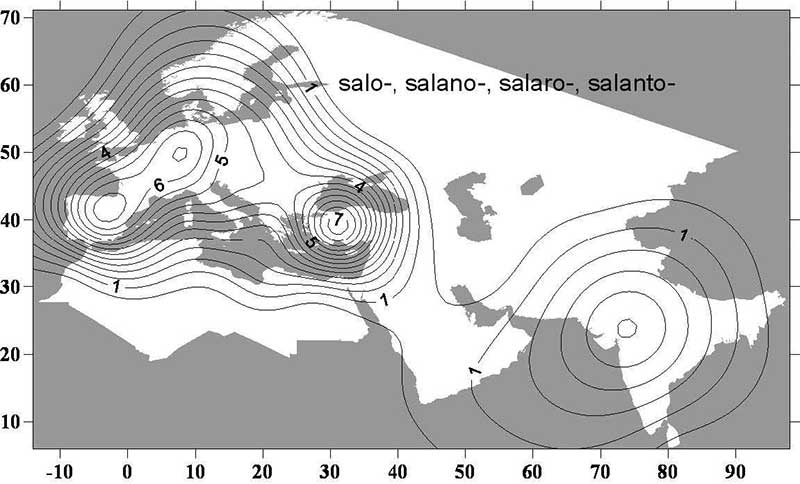
Salacia, Salacia, Salaeni, Salam, Salandona, Salangi, Salangi , Salaniana, Sãlantas,
Salapa, Salapeni, Salaphitanum, Salapia / Salpia / Salapina palus / Salpe, Salar, Salara, Salarama,
Salarbima, Salariga, Salars, Salas, Salat, Salauris, Salcitani, Sale, Sale, Sale, Sale
stagnum, Salecon, Saleia, Salentina, Salentini, Salernum, Salerni, Sales, Sali, Salia, Salia,
Salica, Salica, Salice, Salii, Salija, Salinẽlis, Salìnis, Salìnis, Salìnis, Salìnis, Salinsae, Salionca,
Salius, Salō, Salō, Saloca, Salodurum, Salona, Salonae, Salonenica, Salonia, Saloniana,
Salonime, Salonium, Salontia, Saluca, Salum, Salum, Salunatasi, Saluntum / Salluntum,
Salùpis, Sãlupis, Salur, Salurnis, Selepitani, Sõlis.
The defenders of that alternative have to assume that the process of dialectalization, that before the migrations from the Urheimat was separating into the different Indo-European branches, affected each of them in the phonetic aspect in the general naming vocabulary, but left them unaltered in its phonetic predialectal state with regards to hydro-toponymy, as well as a good part of the naming lexicon related to the concepts of “river, water” and the different qualities of water currents. For example, according to those sharing that opinion, the Hispanic Palantia of the area of Vaccei would be in fact Celtic, but in that name the loss of the initial /p/ that characterizes Celtic would not have been applicable. Similarly, the hydro-toponymy in Germania is largely exempt from the Lautverschiebung, in Greece the loss of initial /s/, etc. These names not only fail to suffer the dialectal innovations corresponding to their zones, but sometimes they present innovations different from the features of the dialect involved. For example the word *mori “sea, standing water” is sometimes found in the hydro-toponymy of Gaul in the form *mari instead of *mori proper of Celtic (Marantium, Marisanga, Marsus), which in the framework of the paradigm has to be inevitably interpreted as a non-Celtic innovation.
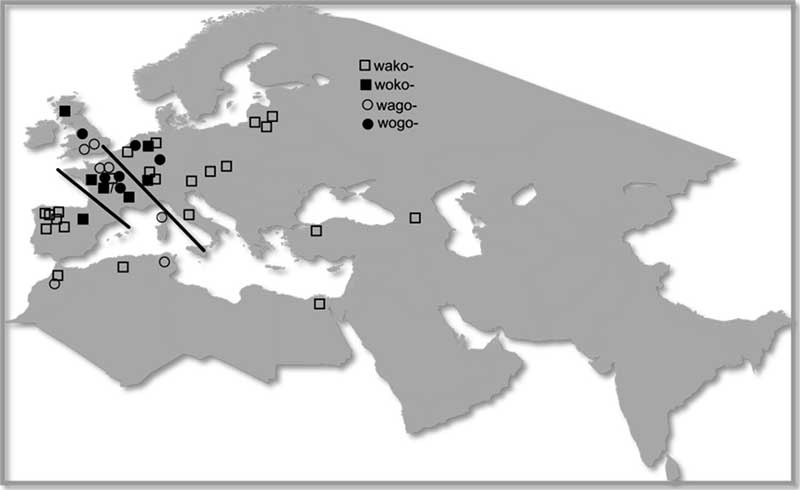
Names of this nature that appear in areas where a pre-Roman historical Indo-European language never existed remain unexplained, such as in North Africa, Arabia Felix or the Caucasus: Lake Pallantias in Libya; the Salat River in Mauritania Tingitana; Auso in Mauritania Caesariensis; the Alonta River in Georgia; the Abas River in Caucasian Albania; Salma and Salapeni in Arabia Felix; etc. Of course, for these cases it is always possible to deny any relationship of kinship between these forms and their European cognates, and attribute everything to the chance of random homophonies. Thus, once again, the annoying comparative data are sacrificed in the sacred altar of the paradigm, despite the fact that they are so numerous and consistent that if there were no blind faith in the current dogma, they would be sufficient to articulate a new paradigm over them.
The choice of each Indo-Europeanist between the non-Indo-European and the Indo-European interpretation to explain the prehistoric toponymy of Europe is not motivated by the fact that they manage partial sets of hydronyms that are more propitious alternatively for the one or the other option. On the contrary, frequently the same batch of materials is claimed by both trends as its own. An extreme example is that of Th. Vennemann, who considers simply as non-Indo-European (specifically Paleo-Basque) exactly the same material that H. Krahe used to support his Indo-European interpretation. Thus, the structure and linguistic characteristics of the studied material have little role in the choice of one or the other path, which is rather conditioned by convictions and adhesion to a varied range of personal beliefs, traditional dogmas and scientific paradigms.
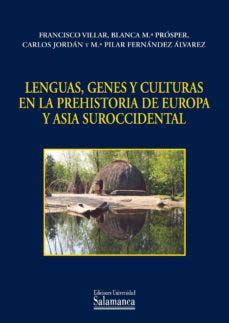
The linguistic column
The sequence of languages that were successively spoken in any territory constitutes what by analogy [with the “geological column”] we could call its “ethno-linguistic column”.
Next I offer the list of the languages detected in the compositional (and to a lesser extent derivational) toponymic syntagms in which the appellatives ub-, up-, ab-, ap-, ur-, il-, igi, tuk, -ip – analyzed in this work – are involved.
From the interaction of the different strata in words and hybrid syntagms we can, therefore, establish the linguistic column in the Iberian Peninsula and its neighboring territories (Western Europe and Northern Africa) with the following sequence:
1. A first stratum of very old chronology, which in a previous publication I have proposed to call Palaeo-Indo-European [“arqueo-indoeuropeo”]. The toponymic elements belonging to this stratum dealt with throughout this text are abundant: kerso-, turso-, alawo-, lako-, mido-, silo-, tibo-, etc.
They always function as determinant toponyms of a place-name in any other language. It never uses the name “city” (or “river”) in hybrid syntagms. Their place names (determinants) are combined with names of the following languages:
a) Iberian in Iberia or Southern France: kiŕś-iltiŕ, tuŕś-iltiŕ, alaun-iltiŕte, lakunm ∙ -iltiŕte.
b) The language of the igi in southern Iberia and perhaps Northern Africa: Cantigi, Saltigi, Sagigi, Sicingi.
c) The southern language of the postponed -il: Mid-ili, Sil-ili, Tib-ili.
d) The language of the postponed -ip: Lac-ipo, Ost-ipo, Vent-ipo.
e) Celtic in Gaul: kerso-ialos > Cersolius > Cerseuil; Ibili-duros > Ibliodurus.

This first Palaeo-Indo-European layer also corresponds to:
Several Palaeo-Indo-European varieties that have ab-, ap-, ub-, up- as a name for «river». To them belong also numerous place names (balsa-, siko-, wol-, etc.) that act as first members composed in both monoglotic and hybrid syntagmas.
Palaeo-Indo-European varieties in which ur- is the name “river”.
2. The second stratum in decreasing order of antiquity is formed by the language of the place name igi “city”, although its presence is only verified with certainty in Iberia (especially in the south) and Northern Africa:
a) It sets the igi name in compounds with Palaeo-Indo-European toponyms as in Salt-, Ast-, Olont-, Cant-, Aur- (Hispania) and Sagigi, Sicingi (Northern Africa).
b) It works as the first place-name of the compound when the second is il: Igilium, Igilgili, Singili.
3. The third stratum is the language of the name il “city”:
a) It puts the nickname il as determined in hybrid syntagms with Palaeo-Indo-European determinants: Mid-ili, Sil-ili, Tib-ili.
b) It puts the nickname il as determined in hybrid syntagms with determinant toponyms igi: Igilium, Igilgili, Singili.
c) It puts the place names (determinants) in front of the name (determined) of the language -ip (Il-ipa, Il-ipula and Il-ipla).
4. Fourth is the language of the name ip- “city”, which puts the name (determined) in syntagms with:
a) Palaeo-Indo-European toponym (determinant): Lac-ipo, Ost-ipo, Vent-ipo.
b) Toponym (determinant) il: Ilipa.
c) Second generation hybrid toponym of Palaeo-Indo-European + il: Balsilippa.
d) In the Balsilippa and Sicilippa conglomerates, the three strata appear in the expected sequence: Palaeo-Indo-European + il + ip.
5. In the fifth place of the sequence is the language of the tuk-:
a) It puts the name tuk- in compounds in which the place-name is a Palaeo-Indo-European element: Acatucci (see Aduatuci in Germania).
b) It puts the name tuk- “height, top” in compounds in which the place-name is an ip- fossilized as place-names: Iptuci, etc.
c) On at least one occasion an ip-fossilized syntagm acts as a toponym opposite a Celtic name: Itucodon (<Iptuco-dunum).
NOTE. Even though Villar talks about this stratum -tuk in Germania (Aduatukus) and the British Isles (Itucodon), only one case is found in each territory.
6. The last place is occupied by Celtic:
a) In Itucodon it puts the name (dunum) in front of a complex toponym of two previous strata, ip- + tuk-; and in Iliodurus it gives the name duro- in front of an equally complex Ibliodurus (<Ibili + duro).
b) In bilbiliz it puts the casual morpheme in a fossilized bi-member toponym of a previous stratum, one of whose components is il-: Bilbil-iz.
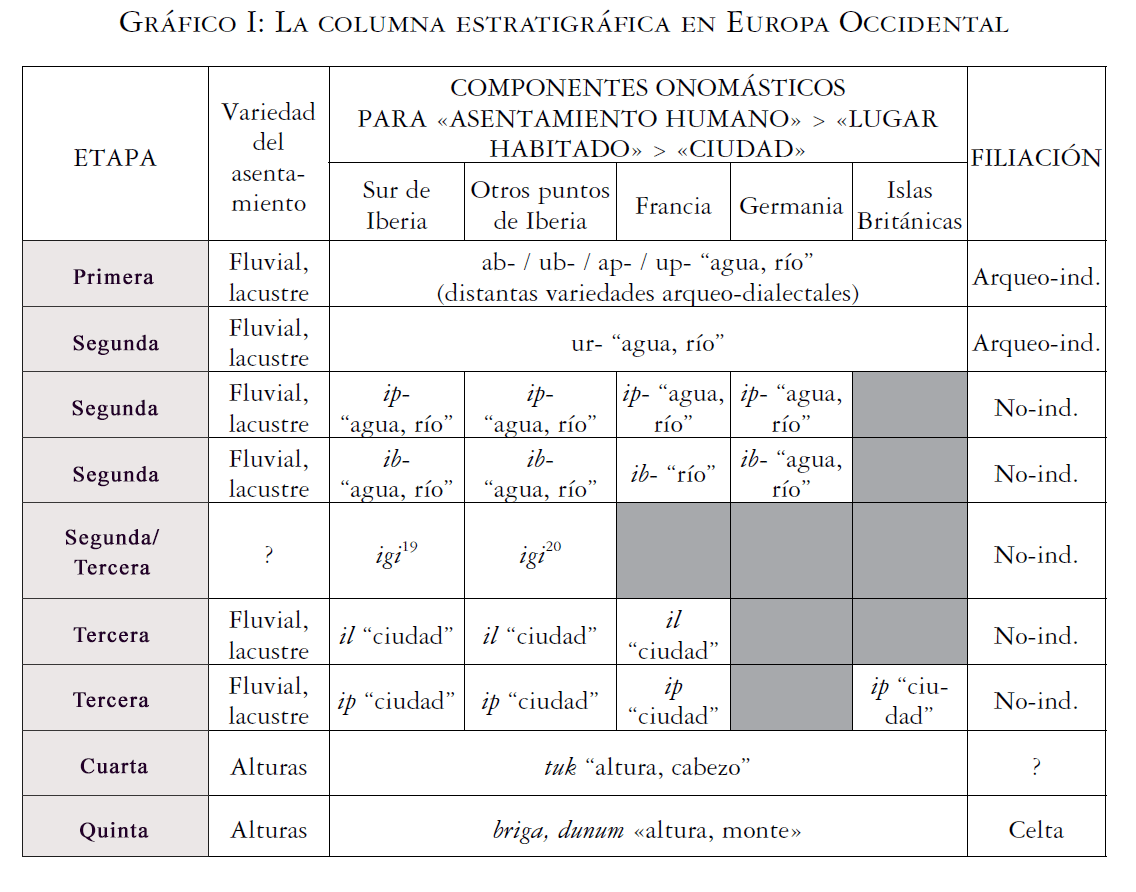
A hard change of paradigm
More effort did it cost me to accept that ub- is a dialectal variant of a known Indo-European word for “water, river”, of which previously knew three others: ap-, ab-, up-. The obviousness of the phonetic correlation ap- / ab- // up- / ub- together with the semantic link with rivers, which can be verified above all outside of Spain, but is also present in our Peninsula, forced my resistance little by little. And with it fell the first trench of the dogma, unshakable until that moment, that everything in the Peninsula in the south was to be non-Indo-European.
Along with this serial component, many other isolated place names were revealed as very likely of Indo-European etymology, both in the “Iberian” East and in the “Tartessian” South. So the ubiquity of Indo-European throughout the Peninsula began to impose itself to me painfully. I say painfully because I lacked a paradigm in which to fit the new perspective that was making its way into my mind, which was therefore suspended in nothing, without any theoretical support, leaving me with a feeling that I was losing my footing. And for a time I was reluctant to accept the profound implications that all of this had entailed.
All il languages, in any of their locations, exhibit a compositional behavior in hybrid toponymic syntagms that place them all in an intermediate position between the clearly [first/second layer] strata, with place-names for their human settlements semantically derived from water realities (ur), and those clearly attributable to the [fifth layer] with appellations derived from settlements in heights (briga, dunum). But in that intermediate segment of the column there are three strata: 1) il, 2) ip-, 3) tuk-. In Andalusia there is an additional one: the igi stratum, of opaque semantics, which immediately precedes the il stratum.
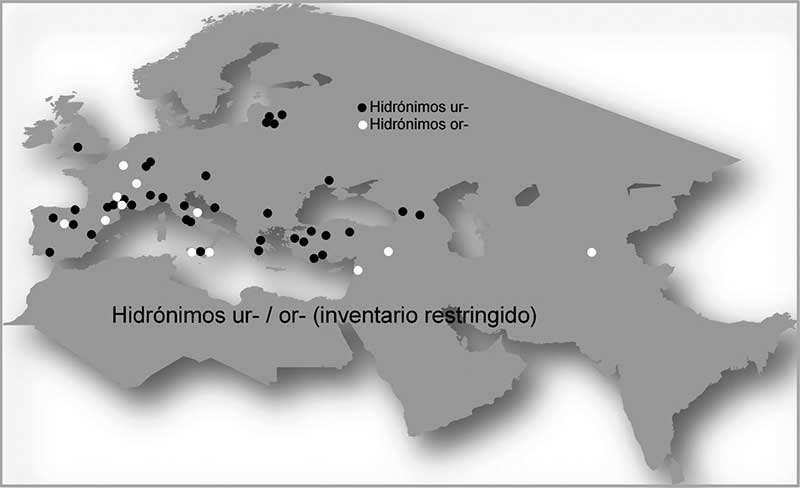
To postulate that any of the toponymic strata of our column imply a new linguistic stratum, certain additional requirements will be necessary. One of them is that, in addition to the name in question, the languages involved should share other features that could not have been lent, such as the very precise order of elements in the compounds Toponym + Name coexisting with Name + Adjective. Or the sharing of additional lexical elements that are not usually subject to loans, such as the semantically basic adjectives beri «new» and bels «black».
Unfortunately, the toponymic method, like the Comparative Method itself, does not have the capacity to establish precise absolute chronologies. (…)
Linguistic chronology

In Europe (Hispania, South of France, Germania, British Isles, Baltic) the oldest stratum that can be identified is an indeterminable number of palaeo-varieties of the Indo-European macro-family, which do not have a direct local relationship with historical Indo-European languages, to the extent that we can verify. In fact, we have seen that stratigraphic signs lead us to consider the main Indo-European pre-Roman language of Hispania, the Celtic language, as a stratum after the il language, which in turn is later than the peninsular Indo-European palaeo-varieties.
In North Africa there is also a Palaeo-Indo-European stratum present. But there is also a very old non-Indo-European stratum whose identity I can not define through the material used. Nor has it been possible for me to establish relative antiquity of one and the other on African soil.
Another of the languages involved, which has il- as an appellation for “city” in the Southwest of Hispania and North Africa, could have some kind of kinship relationship with Basque on the one hand and the Iberian language on the other, but the same indirect form that I have just pointed out for the Indo-European palaeo-varieties with respect to the historical Indo-European languages. Or in other words: the language(s) of the place-names referred to in this work would be palaeo-varieties of a linguistic family to which two known historical languages, Iberian and Basque, may have belonged, although we can’t establish a relation of direct affiliation neither between those two historical languages among themselves, nor between any of them and the palaeo-varieties of the prehistoric toponymy.
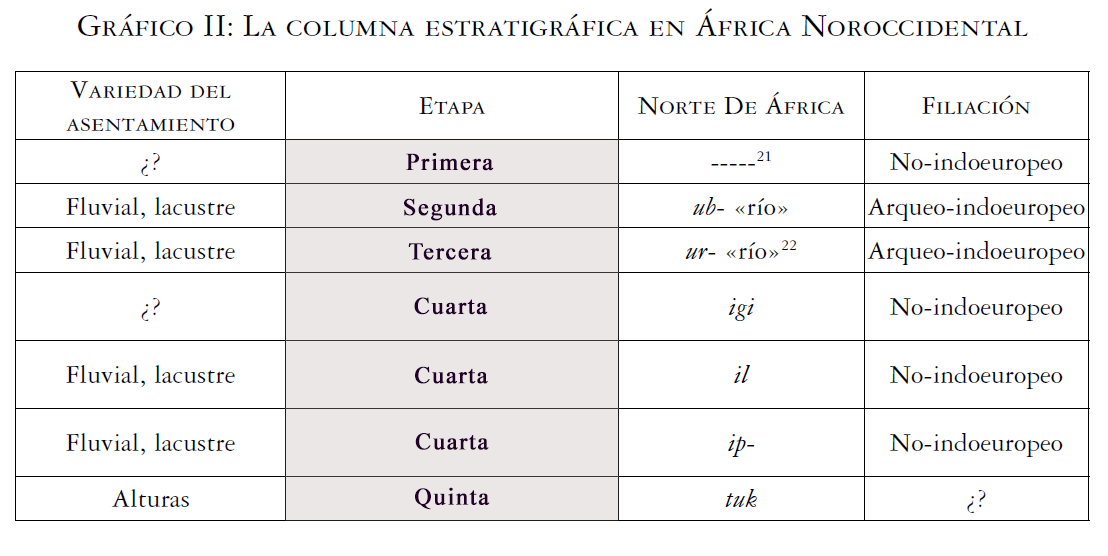
In general, Celtic does not have in its historical territories the onomastic behavior of an ancestral language, but that of an intrusive language, whose presence there is not only more recent than other Indo-European varieties, but also after that of various non-Indo-European strata, which are themselves ranked between the oldest detected (Palaeo-Indo-European) and the last of Pre-Romans, which is Celtic itself. If we only detected two strata, the Indo-European and the Celtic ones, we could discuss if it is possible that both are one and the same, so that what we define as “Celtic” is nothing other than the modern in situ evolution of Palaeo-Indo-European. But examples like those of kiŕśiltiŕ, kerso-ialos, Cirsa or Itucodon, among many others analyzed throughout this book, make it unlikely. And, in addition, the mediation of several strata in the column between the Palaeo-Indo-European language of Cirsa, as well as the greater antiquity of the ip- and tuk- languages in Spanish, Gallic and British territory, defines the latter as a new and more recent layer than the aforementioned, which burst into its historical sites during the Iron Age.
Because Archaeology continues to deny the existence of population movements of a size worthy of consideration in the Iron Age, it is necessary to accept that the Indo-European Problem remains intact. It is understandable that before this aporia, many minds who are uncomfortable living with doubts, prefer to adopt a creed (the traditional, the Neolithic or the continuist) and expose it as a certainty to their students in the classrooms or their colleagues in conferences and publications. It’s not my case. For me, with Voltaire, “le doute est désagréable, mais la certitude est ridicule”. Or with Manzoni: “E men male l’agitarsi nel dubbio, che riposar nell’errore”.
Continue reading on European hydrotoponymy (II): Basques, Iberians, and Etruscans after Old Europeans.
Related
- Aquitanians and Iberians of haplogroup R1b are exactly like Indo-Iranians and Balto-Slavs of haplogroup R1a
- Iberia: East Bell Beakers spread Indo-European languages; Celts expanded later
- Iberia in the Copper and Early Bronze Age: Cultural, demographic, and environmental analysis
- Haplogroup R1b-M167/SRY2627 linked to Celts expanding with the Urnfield culture
- Analysis of R1b-DF27 haplogroups in modern populations adds new information that contrasts with ‘steppe admixture’ results
- On Latin, Turkic, and Celtic – likely stories of mixed societies and little genetic impact
- Patterns of genetic differentiation and the footprints of historical migrations in the Iberian Peninsula
- First Iberian R1b-DF27 sample, probably from incoming East Bell Beakers
- Ancient Sardinia hints at Mesolithic spread of R1b-V88, and Western EEF-related expansion of Vasconic
- Arrival of steppe ancestry with R1b-P312 in the Mediterranean: Balearic Islands, Sicily, and Iron Age Sardinia
- Modern Sardinians show elevated Neolithic farmer ancestry shared with Basques
- Iberian prehistoric migrations in Genomics from Neolithic, Chalcolithic, and Bronze Age
